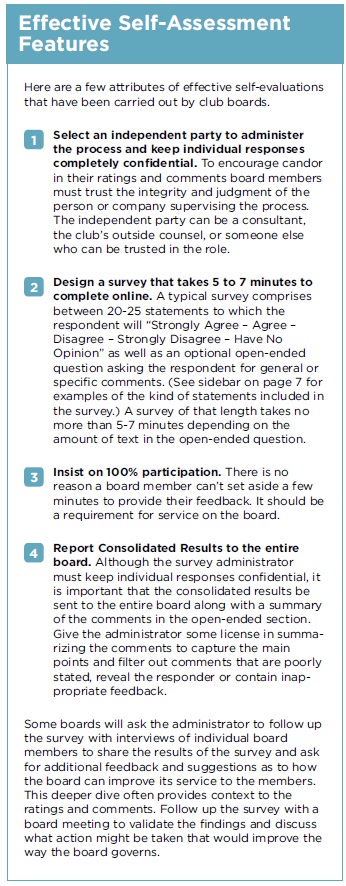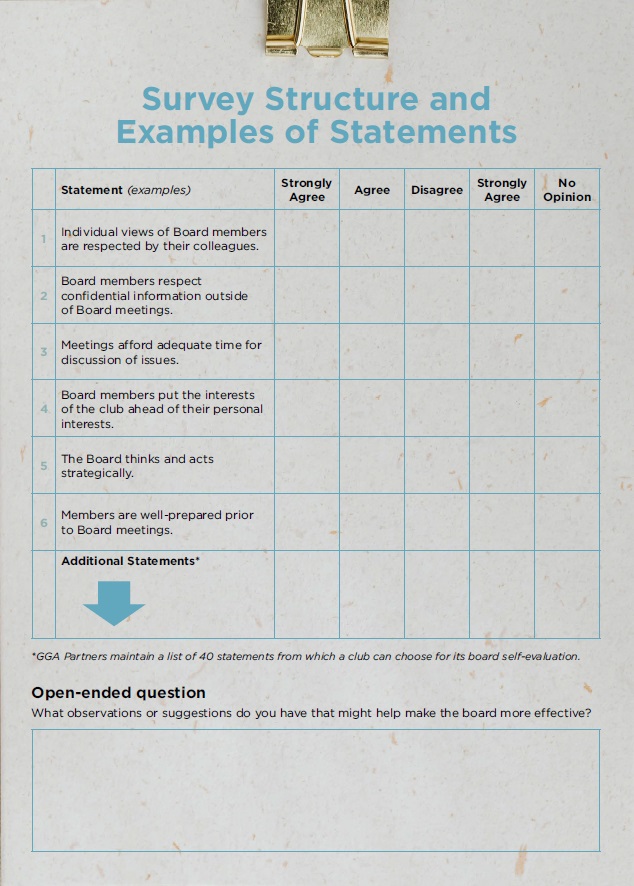Capturing Member Perception of the Club’s Board of Directors
Each year, GGA Partners conducts scores of member focus groups and member surveys to help clubs understand the views of their members on a wide range of topics from the condition of the fairways on the golf course to policies regulating dress and decorum in the clubhouse. Members are asked to rate their level of satisfaction with such matters as the appropriateness of certain rules, the quality of various amenities, the level of service provided by the staff, and the like. While the ratings tend to vary by topic across clubs, there is one subject area that seems to attract more than its share of negative ratings and/or comments—that being the members’ perception the club’s governance. Typical member ratings of their boards include “out of touch,” “not transparent,” “inefficient” and “micromanaging.”
Because members may have limited awareness of what goes on during board meetings or the board policies and procedures, these negative descriptors may not be accurate. Even so, gaining feedback from members is a good practice, including perceptions of the club’s governance structure in general and the effectiveness of their board in particular. Members’ evaluation of the board is largely based on the frequency and content of communications from the board rather than on any specific knowledge of the board’s efficiency and effectiveness. Getting at those important features calls for an evaluation by the those who are at the heart of the club’s governance model—the board members themselves.

Board Self-Assessments: Is the Juice Worth the Squeeze?
Although it is commonplace for members to periodically rate the board on an annual survey, it is rare for the board members themselves to evaluate the club’s governance model. Yet these are the people most qualified to make that assessment. If the feedback from member focus groups and surveys centers mainly on the board’s communication and transparency, why don’t boards collect more valuable feedback from the board members who have a firsthand look at board efficiency and effectiveness? Before answering that question, let’s examine what value accrues to a board by conducting a self-evaluation and whether the benefits are worth the effort.
Benefits are both quantitative and qualitative. On the quantitative side are ratings on board meeting content and conduct, board policies and procedures, board leadership, board member participation, and the like. The primary qualitative benefit is the message to board members that board leadership values their opinions. Moreover, if self-evaluation is a well-established annual process, it provides a scorecard for both the leadership and the board members. Just as students will study for a test if they know what’s on it, so board members will align their performance with the metrics on the self-evaluation.
So, if self-evaluation is so great, why don’t more club boards carry it out? Perhaps it’s a reluctance to “air dirty laundry” by revealing areas that need work. Or maybe the chair feels the board is doing just fine, and doesn’t believe a self-evaluation would disclose any areas for improvement. To be sure, it takes strong leaders to subject themselves to scrutiny. None of us likes to be criticized and an evaluation by one’s colleagues is basically an invitation for them to be critical. However, by following a few basic principles and practices, a board can conduct a self-evaluation that encourages both positive feedback and constructive criticism.
What Gets Measured Gets Done
A fundamental principle of good club governance is the clear trace of authority and accountability. While most clubs articulate the authority of the board in their bylaws, few boards have established a policy for holding themselves accountable to their members. Surveys of club members are helpful, but they tend to measure perception. Greater accountability is achieved by boards that conduct properly designed and well-executed self-evaluations. An annual self-evaluation can set a high standard for individual board members and for the board as a whole.
There is an oft-repeated bromide that “what gets measured gets done.” Few boards truly measure their performance. Those that do are more likely to “get it done”—in reality as well in the eyes of members.



